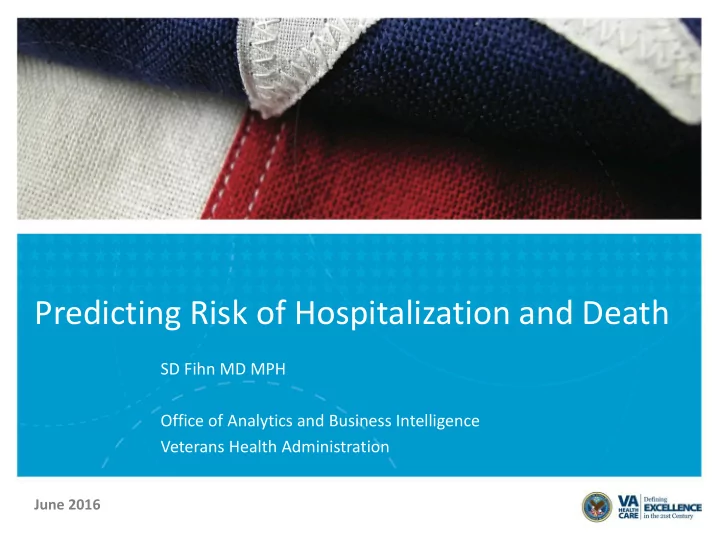

Predicting Risk of Hospitalization and Death SD Fihn MD MPH Office of Analytics and Business Intelligence Veterans Health Administration June 2016
Care Assessment Need (CAN) Score • Initial CAN developed from data on 4.5M veterans enrolled in primary care using standard and multinomial (polytomous) logistic regression (Wang L, et al. Med Care 2013;51:368-73) – ~90 input variables from 7 domains in corporate data warehouse • CAN 2.0 deployed in 2016 – Reduced to 36 input variables including composite SES index derived from US CENSUS American Community Survey plus Rank & Service Branch from VA/DOD Identity repository . – Improved concordance (C-statistic) and calibration – Weekly report provides CAN scores & probabilities for 3 outcomes at 90d and 1yr: Mortality, Hospitalization, Mortality or Hospitalization VETERANS HEALTH ADMINISTRATION 2
Input Variables Demographics Utilization Chronic Illness Pharmacy Age Group No. Hospital/Bed Days Deyo-Charlson Score Antipsychotic Air Force Flag No. Medical Providers HCCs: Beta-blocker Eligibility (1, [2-4], 5+) No. Visit Type: AFib and CHF Benzodiazepine Rank Flag (Officer vs Enlisted) All Dementia Beta agonist nebulizer Marital Status Inpatient Mental Health and PTSD Furosemide Priority Emergency Care Metastatic Cancer Statin SES index Cardiology Alcohol Metformin Sex CT Chronic Airway Obstruction NSAID Mental Health Furosemide Tablets Vital Signs Other Non-Face No. of drugs filled Lab/Radiology BMI (≥40) Primary Care (PC) No. Albumin Weight Variability Phone Care Text Notes No. Blood, Urine, Nitrogen HR (80-60) PC Phone Care Lymphocytes (Low) No. Consent Notes Resp Rate (≥20) No. 11-20min Phone Red Blood Cells (Low) No. Telephone Notes Sys & Dias BP No. 21-30min Phone Sodium (Low) No. Est Office Visit White Blood Cells (High) No. Troponin No. Chest X-Ray VETERANS HEALTH ADMINISTRATION
Predictive Accuracy Hospitalization - 1 year 0.81 Hospitalization - 90 day 0.83 Mortality - 1 year 0.85 Mortality - 90 day 0.87 Veterans in highest %ile of risk have 58% probability of admission, 23% probability of death, and 64% probability of either event. VETERANS HEALTH ADMINISTRATION
Risk Data Updated Weekly VETERANS HEALTH ADMINISTRATION
Use of High Level Analytic Data for Population Management and Resource Planning 1-yr likelihood of admission or death 2.37% - 9.03% 9.04% - 10.01% 10.02% - 10.96% 10.97% - 12.18% 12.19% - 19.34% 1-yr likelihood of admission 1.86% - 5.93% 5.94% - 7.00% 7.01% - 7.97% 7.98% - 9.21% 9.22% - 16.99% Fihn, et al Health Affairs 2014 VETERANS HEALTH ADMINISTRATION 12
CAN USAGE 2014 - 2016 2016 8,000 2015 7,000 2014 6,000 5,000 4,000 3,000 2,000 No. of CAN “hits” by month 2000 1,000 - 1500 1000 2014 May underestimate usage 2015 because nurse care managers 500 2016 download data for several No. of CAN users by month providers & data can be 0 downloaded directly from regional data warehouses VETERANS HEALTH ADMINISTRATION 7
Few Patients with High Scores Referred to Coordination Programs Telehealth, HBPC, Palliative Care, and Hospice Palliative Care Score ≥ 95 --5,000 of 268,833 total patients (1.9%) Hospice Score ≥ 95 -- 775 of 268,833 total patients (0.2%) VETERANS HEALTH ADMINISTRATION
IRT (Item Response Theory) Analysis of Highest Risk Patients Reveals High Complexity Cardiac Complex Cancer Substance Complex Mental Health Diabetes Abuse Drug Abuse 92% 3% 0% 4% 2% Depression 64% 96% 11% 7% 15% Anxiety 25% 38% 9% 8% 8% Diabetes 19% 42% 43% 70% 45% Renal Failure 4% 7% 19% 33% 13% CHF 8% 7% 83% 19% 16% Tumor 10% 14% 9% 0% 100% VETERANS HEALTH ADMINISTRATION 9
Patient Care Assessment System (PCAS) Web application to provide Patient Aligned Care Teams (PACT) with tools to identify and coor- dinate care for paneled patients, especially those at highest risk. RELEASE 1 (Dec 2013) • Panel Overview • PACT Team Management • Consult Monitoring • Demographics & Caregiver Contacts • Risk Characteristics (including CAN) RELEASE 2 (Jun 2015) • Tasks & Notifications • 6-12 mon. of VA and Non-VA Clinical Data for all active primary care patients (>5M) • One-click Panel Filters for High Risk Sub-Populations VETERANS HEALTH ADMINISTRATION 10
PCAS Release 3.0 & Implementation RELEASE 3.0 (2016) • Full Care Planning and Tracking • Basic and Dynamic Care Plan Notes • Note Integration with CPRS • Advanced Panel Queries • Clinical Practice Guideline Links and Clinical Training Resources IMPLEMENTATION • Structured implementation began with PCAS 2.0 • 300% increase in utilization since 2.0 • Users in every VISN (VISN 4 highest) / 1000+ Users VETERANS HEALTH ADMINISTRATION 11
Recommend
More recommend